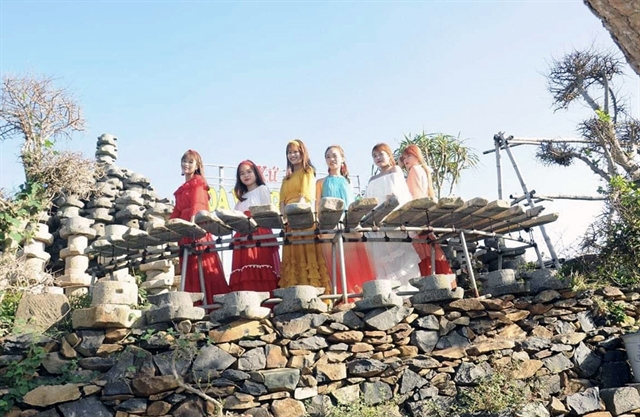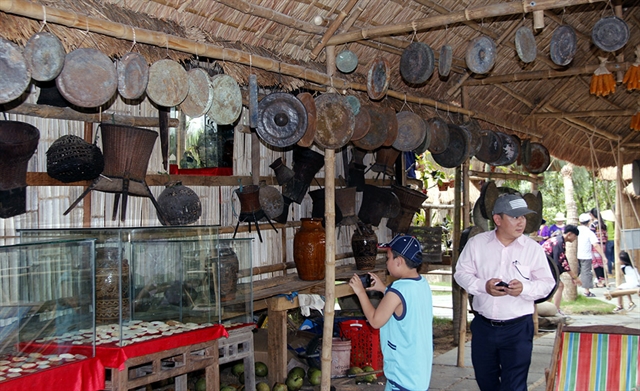The melodious rhythms of stone lithophone at popular destinations in the central province of Phú Yên - such as Gành Đá Dĩa (seashore area of uniformly interlocking basalt rock columns located along the coast in An Ninh Đông Commune), Tuy An District and Tháp Nhạn (Nhạn Tower, a Chăm structure in Tuy Hoà City) - have lured many visitors.
by Hiền Nguyễn
The melodious rhythms of lithophones at popular tourist destinations in the central province of Phú Yên - such as Gành Đá Dĩa in Tuy An District and Tháp Nhạn (Nhạn Tower, an ethnic Chăm tower in Tuy Hoà City) - have lured many visitors.
The performances of the ancient musical instruments have been a new tourism product at these destinations.
Nguyễn Minh Nghiệp, a local resident, and some colleagues were the initiators of the show.
“From my passion for stone slabs that can produce echoed melodious sounds, since 2013, I have collected stone slabs in the high mountainous area of Tuy An District to make a set of lithophone with all musical notes,” he said.
After gathering suitable stone pieces, he carved them further to enable them to create clear sounds.

Nguyễn Minh Nghiệp carves on stone slabs to make musical instruments. Photo baovanhoa.vn
At the beginning of 2017, he had the initiative to bring the lithophone set to perform at famous destinations for tourists.
Then, he trained younger musicians to perform this particular kind of instrument.
At present, when visiting the Gành Đá Dĩa National Special Heritage Site, tourists can enjoy lithophone performances featuring various Vietnamese songs such as Cô Gái Vót Chông, Tiếng Đàn Ta Lư and Sông Đăkrông Mùa Xuân Về.
The performers also offer other modern pieces of music.
Lê Thị Mỹ Bình, a visitor from Bình Định Province, cannot hide her excitement.
“My family was impressed very much with the show,” she said. “Each piece of stone in Phú Yên can create such magical melodious sounds.”

Visitors like the show. VNS Photo Quỳnh Mai
Bình said she thought lithophones should be performed at more landmarks to entertain visitors.
The same performances are available at Nhạn Tower in Tuy Hòa City.
The show includes songs about Phú Yên and songs from the movie Tôi Thấy Hoa Vàng Trên Cỏ Xanh (Yellow Flowers on Green Grass) shot in Phú Yên.
“Clear melodious sounds echoing in a space of ancient architecture bring a fresh experience to me even though I have been here several times,” said tourist Dương Khánh Lâm from HCM City.
Nghiệp so far has made 20 sets of lithophone. Each set has 19-42 stone slabs of various sizes. Two sets among the 20 sets were totally intact natural stones without being carved or further retouched.

Visitors pose for a photo with the musical stone instrument set. VNS Photo Quỳnh Mai
Explaining the appearance of Phú Yên lithophones, Nguyễn Thị Hồng Thái, director of Phú Yên Culture, Sports and Tourism Department, said in 1990-1991, locals discovered an ancient set of stone musical instruments while farming at the foot of Một Mountain, in Trung Lương Village, An Nghiệp Commune, Tuy An District.
In 1992, they donated the set to Phú Yên Provincial Museum.
Archaeologists then determined the set was made around the 5th century BC.
The department then submitted a dossier to the culture ministry to seek its recognition of the stone instruments as a national treasure.
“The Tuy An lithophone set is an important part of lithophone collections found throughout Việt Nam,” Thái said.
The Tuy An lithophone set has all musical notes, the most complete of its kind in the country.
“In fact, the lithophone can be used to perform various folk music pieces of some ethnic minority groups in the country,” she said. “It can combine with other instruments to perform modern melodies as well.” VNS

An exhibition space at Gành Đá Dĩa site to display metal gong instruments. VNS Photo Quỳnh Mai